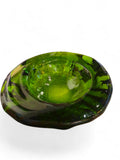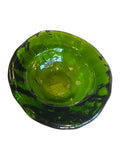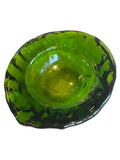


FREE-FORM EMERALD GREEN GLASS ASHTRAY/VIDE POCHE BY BLENKO
CONTACT US HERE ABOUT THIS ITEM.
Emerald green, oblong, free-form ashtray/vide poche, featuring a broad, flat rim and a round bowl. Crafted from hand-blown glass in the 1960s by BLENKO.
BLENKO GLASS COMPANY is a family-owned business in Milton, W. Va., specializing in hand-blown glass. It was established in 1921 as the Eureka Art Glass Company by Englishman William John Blenko (1854–1934), who was determined to introduce Old World sheet-glass production methods in the US. Blenko immigrated to America in 1893, ultimately settling in Milton after several attempts to launch factories at other locations. The Industrial Development Department of the Chesapeake & Ohio Railroad sold him on Milton's potential, highlighting its sober and diligent workforce as well as the dependable supply of natural gas for the kilns. He began construction of a furnace with the assistance of a few locals, and, within a month, handmade glass was being manufactured. (Along with natural gas, the presence of rich silica deposits and access to both river and rail transportation led to West Virginia’s becoming a center for glass manufacturing after the Civil War.)
William J. was solely responsible for both production and sales of glass until the arrival in 1923 of his son and daughter-in-law—William H. Blenko (d. 1969) and his wife Marion (née Hunt)—who were integrated into the workforce. In 1925, the need for a larger workshop and improved shipping facilities prompted the relocation of the BLENKO glassworks across the river to its current site, near the main line of the C&O Railroad. The operation received a notable commission in 1927 when British architect Sir Giles Gilbert Scott chose it to produce glass for the windows of Liverpool Cathedral. Another early achievement included furnishing glass for the windows of St. Patrick’s in New York City.
The onset of the Great Depression, which decimated the market for stained glass, made it obvious that the product line had to expand beyond sheet glass. Consequently, in 1929, the services of two Swedish-American glassblowers were enlisted: brothers Louis Miller and Axel Müller (the latter of whom chose not to Americanize his name). They trained the Milton crews in the art of handcrafting decorative objects—the vases, pitchers, and stemware that would ultimately establish BLENKO’s international reputation. An early client was the Boston importer Carbone and Sons, which previously had sourced its goods from Italy and Sweden.
Growing demand was met with increased production, and, in 1930, the company was rebranded as the BLENKO GLASS COMPANY, alongside the launch of the tableware line that would make “Blenko” a household name. In 1932, Macy’s began selling BLENKO in New York City. After the death of founder William J. in 1934, William H. assumed leadership and would oversee consistent growth at the company for three decades before retiring. His wife, Marion, held the positions of treasurer, secretary, and retail sales manager until her passing in 1989.
Since the mid-1930s, BLENKO has presented its product range in an annual catalog. The first color version was published in 1959, under the direction of designer Wayne Husted (b. 1927). As the company launched new shades and retired others, a dedicated page was created to list the available colors—often with evocative names. In the early 1960s, turquoise, amethyst, tangerine, sea green, jonquil, crystal, and rosé were featured; as the decade progressed, chestnut, honey, peacock, plum, lemon, and wheat were introduced. Collectors, dealers, and curators actively seek out past catalogs to help them identify and authenticate BLENKO items.
While many different production techniques have been employed at BLENKO, the company is particularly known for its use of molds. Hand-carved cherrywood molds, for example, are employed to shape its blown tableware. While considerably less expensive than metal ones, wooden molds wear out after fifty to a hundred uses. More durable cast-iron molds are used for objects made in quantity, such as BLENKO’s signature 384 Water Bottle (in continuous production since 1938).
In 1947, a significant change occurred with the appointment of Winslow Anderson (1917–2007) as the full-time design director. His team’s work garnered critical acclaim, with several of Anderson's designs being awarded MoMA’s Good Design Awards in 1950, establishing the company as a frontrunner in modern American glass throughout the ’50s and ’60s. The company’s “Historic Period”—of particular interest to collectors—began with Anderson and ran through the tenure of John Nickerson (b. 1939) until 1974 (see below). BLENKO’s second design director, Wayne Husted, significantly advanced the company into the avant-garde, particularly by pioneering the idea of "architectural-scale" designs. Husted’s successor, Joel Philip Myers (b. 1934), who is recognized as the founder of the Studio Glass movement, which emphasized the artist’s role as both designer and creator of one-of-a-kind objects, further bolstered the firm's prestige.
BLENKO’S ”HISTORIC” DESIGN DIRECTORS:
- Winslow Anderson, 1947–1953
- Wayne Husted, 1952–1963
- Joel Philip Myers, 1963–1970
- John Nickerson, 1970–1974
The BLENKO GLASS COMPANY filed for Chapter 11 in May 2011. A reorganization plan was accepted by the court in December 2012, clearing the way for the company to exit bankruptcy in early 2013. Now in its fourth generation of family leadership, BLENKO continues to produce new forms and release new shades. Contemporary collectors, prizing more historic designs and colors, have fostered an active secondary market for the company’s glass. In recent years, direct-to-consumer sales of a pair of limited-edition figurines depicting famous local cryptids—the Flatwoods Monster and Mothman—helped to expand BLENKO’s customer base, sustaining its fortunes through the COVID-19 pandemic. The company offers free factory tours to the public that feature an overlook area where visitors can observe its craftspeople at work.
DETAILS
Maker – BLENKO GLASS COMPANY
Production Period/Year – 1960s
Designer – UNKNOWN
Design Period/Year – 1960s
Origin – U.S.A.
Styles/Movements – ABSTRACT; MID-CENTURY MODERN; AMERICAN
Materials – GLASS
Colors – FOREST
Condition – Excellent vintage condition. May show minor signs of previous ownership and use.
Dimensions – 7 ¾" W × 7" D × 2" H



